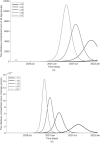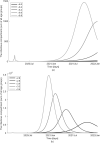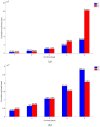The effect of control measures on COVID-19 transmission in South Korea
- PMID: 33780504
- PMCID: PMC8006988
- DOI: 10.1371/journal.pone.0249262
The effect of control measures on COVID-19 transmission in South Korea
Abstract
Countries around the world have taken control measures to mitigate the spread of COVID-19, including Korea. Social distancing is considered an essential strategy to reduce transmission in the absence of vaccination or treatment. While interventions have been successful in controlling COVID-19 in Korea, maintaining the current restrictions incurs great social costs. Thus, it is important to analyze the impact of different polices on the spread of the epidemic. To model the COVID-19 outbreak, we use an extended age-structured SEIR model with quarantine and isolation compartments. The model is calibrated to age-specific cumulative confirmed cases provided by the Korea Disease Control and Prevention Agency (KDCA). Four control measures-school closure, social distancing, quarantine, and isolation-are investigated. Because the infectiousness of the exposed has been controversial, we study two major scenarios, considering contributions to infection of the exposed, the quarantined, and the isolated. Assuming the transmission rate would increase more than 1.7 times after the end of social distancing, a second outbreak is expected in the first scenario. The epidemic threshold for increase of contacts between teenagers after school reopening is 3.3 times, which brings the net reproduction number to 1. The threshold values are higher in the second scenario. If the average time taken until isolation and quarantine reduces from three days to two, cumulative cases are reduced by 60% and 47% in the first scenario, respectively. Meanwhile, the reduction is 33% and 41%, respectively, for rapid isolation and quarantine in the second scenario. Without social distancing, a second wave is possible, irrespective of whether we assume risk of infection by the exposed. In the non-infectivity of the exposed scenario, early detection and isolation are significantly more effective than quarantine. Furthermore, quarantining the exposed is as important as isolating the infectious when we assume that the exposed also contribute to infection.
Conflict of interest statement
The authors have declared that no competing interests exist.
Figures












Similar articles
-
Forecasting the effect of social distancing on COVID-19 autumn-winter outbreak in the metropolitan area of Buenos Aires.Medicina (B Aires). 2020;80 Suppl 3:7-15. Medicina (B Aires). 2020. PMID: 32658842 English.
-
Transmission dynamics and control of two epidemic waves of SARS-CoV-2 in South Korea.BMC Infect Dis. 2021 May 26;21(1):485. doi: 10.1186/s12879-021-06204-6. BMC Infect Dis. 2021. PMID: 34039296 Free PMC article.
-
Effect of Non-lockdown Social Distancing and Testing-Contact Tracing During a COVID-19 Outbreak in Daegu, South Korea, February to April 2020: A Modeling Study.Int J Infect Dis. 2021 Sep;110:213-221. doi: 10.1016/j.ijid.2021.07.058. Epub 2021 Jul 29. Int J Infect Dis. 2021. PMID: 34333119 Free PMC article.
-
The COVID-19 Pandemic-an Epidemiological Perspective.Curr Allergy Asthma Rep. 2021 Apr 28;21(4):29. doi: 10.1007/s11882-021-01007-w. Curr Allergy Asthma Rep. 2021. PMID: 33907920 Free PMC article. Review.
-
Flattening the Curve on COVID-19: South Korea's Measures in Tackling Initial Outbreak of Coronavirus.Am J Epidemiol. 2021 Apr 6;190(4):496-505. doi: 10.1093/aje/kwaa217. Am J Epidemiol. 2021. PMID: 33106843 Free PMC article. Review.
Cited by
-
Transmission of SARS-CoV-2 within households: a remote prospective cohort study in European countries.Eur J Epidemiol. 2022 May;37(5):549-561. doi: 10.1007/s10654-022-00870-9. Epub 2022 May 28. Eur J Epidemiol. 2022. PMID: 35644003 Free PMC article.
-
An age-structured SEIR model for COVID-19 incidence in Dublin, Ireland with framework for evaluating health intervention cost.PLoS One. 2021 Dec 7;16(12):e0260632. doi: 10.1371/journal.pone.0260632. eCollection 2021. PLoS One. 2021. PMID: 34874981 Free PMC article.
-
Assessing Knowledge, Preventive Practices, and Depression Among Chinese International Students and Local Korean Students in South Korea During the COVID-19 Pandemic: An Online Cross-Sectional Study.Front Psychiatry. 2022 Jun 21;13:920887. doi: 10.3389/fpsyt.2022.920887. eCollection 2022. Front Psychiatry. 2022. PMID: 35815006 Free PMC article.
-
Schoolteachers' Resilience Does but Self-Efficacy Does Not Mediate the Influence of Stress and Anxiety Due to the COVID-19 Pandemic on Depression and Subjective Well-Being.Front Psychiatry. 2021 Oct 6;12:756195. doi: 10.3389/fpsyt.2021.756195. eCollection 2021. Front Psychiatry. 2021. PMID: 34690845 Free PMC article.
-
Local-level spatiotemporal dynamics of COVID-19 transmission in the Greater Seoul Area, Korea: a view from a Bayesian perspective.Epidemiol Health. 2022;44:e2022016. doi: 10.4178/epih.e2022016. Epub 2022 Jan 13. Epidemiol Health. 2022. PMID: 35038828 Free PMC article.
References
-
- Kermack WO, McKendrick AG. A contribution to the mathematical theory of epidemics. Proceedings of the royal society of London Series A, Containing papers of a mathematical and physical character. 1927;115(772):700–721.
-
- Hethcote HW. The mathematics of infectious diseases. SIAM review. 2000;42(4):599–653. 10.1137/S0036144500371907 - DOI
-
- Chen Y, Cheng J, Jiang Y, Liu K. A time delay dynamic system with external source for the local outbreak of 2019-nCoV. Applicable Analysis. 2020; p. 1–12.
Publication types
MeSH terms
LinkOut - more resources
Full Text Sources
Other Literature Sources
Medical

